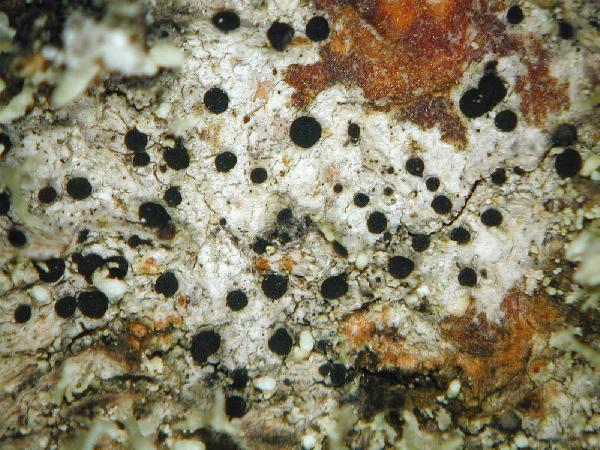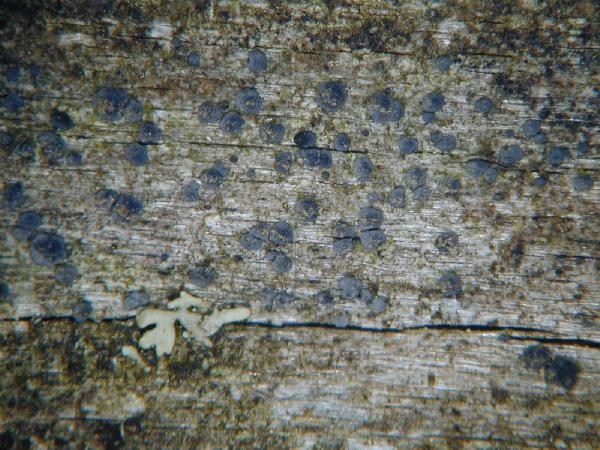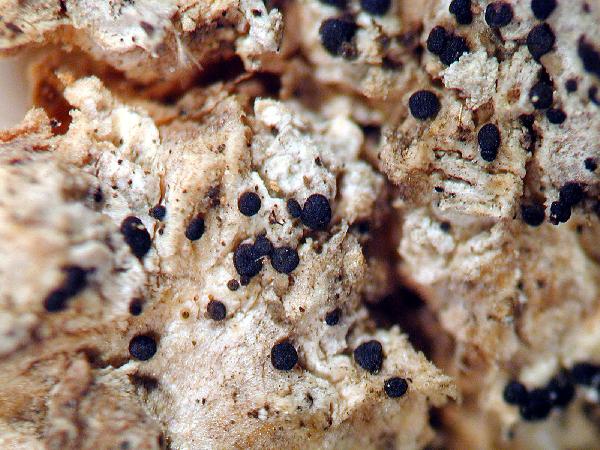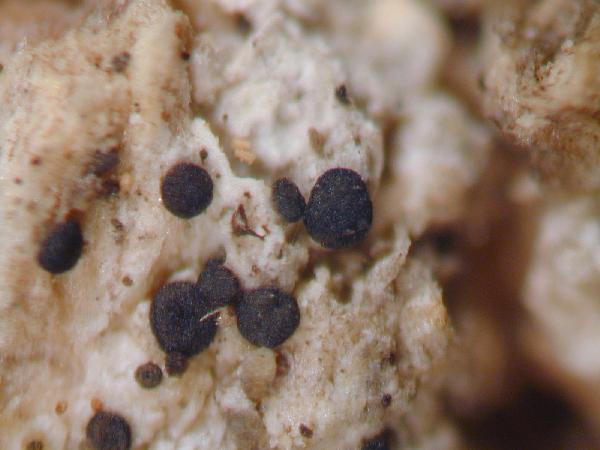Biatora globulosa (Flörke) Fr.
Summa Veg. Scand.: 112, 1845. Basionym: Lecidea globulosa Flörke - Deutschl. Flecht., 10: 1, 1821.
Synonyms: Bacidia globulosa (Flörke) Hafellner & V. Wirth; Bacidia pinguicula (Bagl. & Carestia) Lettau; Biatora hyalina Fr.; Biatora minuta (Schaer.) Hepp; Biatora sylvana Körb.; Biatorina globulosa (Flörke) Körb.; Bilimbia pinguicula Bagl. & Carestia; Bilimbia pyrenocarpoides Anzi; Catillaria globulosa (Flörke) Th. Fr.; Lecania globulosa (Flörke) van den Boom & Sérus. non Savicz; Lecania hyalina (Fr.) R. Sant.; Lecidea sylvana (Körb.) Th. Fr.; Myrionora globulosa (Flörke) S.Y. Kondr.
Description: Thallus crustose, endosubstratic or thinly episubstratic, smooth, minutely granular or rimose-verruculose, whitish grey to ochraceous, esorediate. Apothecia biatorine, brownish black, grey-brown or grey-black, rarely pale in shade-forms, rounded, sessile and constricted at base, 0.2-0.4(-0.7) mm across, with an epruinose or rarely faintly pruinose, weakly to strongly convex disc, and a thin, soon excluded proper margin. Proper exciple 25-30 µm wide laterally, 50-65 µm wide at base, of radiating hyphae with 1.5-2(-3) µm thick lumina, colourless or greyish green in innermost part; epithecium 5-10 µm high, patchily greenish or greyish black, N+ violet, K- or K+ intensifying green; hymenium colourless, 30-40 µm high; paraphyses coherent, simple or sparingly branched in upper part, (0.7-)1-2 µm thick at mid-level, the apical cells somewhat swollen, sometimes with a dark cap, the pigment deposited in the cell walls; subhymenium distinct, 40-75 µm high; hypothecium colourless, 60-100 µm high. Asci 8-spored, clavate, with a K/I+ blue apical dome penetrated by a narrow, K/I– apical cushion surrounded by a narrow, deeply K/I+ blue zone, the wall K/I- but surrounded by an I+ red-brown, K/I+ blue outer layer, the ocular chamber relatively small, Biatora-type. Ascospores 1-celled (rarely 1-septate), hyaline, oblong to subcylindrical, (7-)10-12(-15) x 2-3(-4) µm. Pycnidia dark, globular, immersed, the wall dark green. Conidia of two types: a) cylindrical or curved, 3.5-5 (-6) x 0.5.0.7 μm, b) ellipsoid, 2-2.8 x 1–1.5 μm. Photobiont chlorococcoid, the cells 7-18 µm in diam. Spot tests: thallus K-, C-, KC-, P-, UV-. Chemistry: without lichen substances.
Growth form: Crustose
Substrata: bark
Photobiont: green algae other than Trentepohlia
Reproductive strategy: mainly sexual
Commonnes-rarity: (info)
Alpine belt: absent
Subalpine belt: very rare
Montane belt: rather rare
Dry submediterranean belt: very rare
Humid submediterranean belt: rare
Padanian area: absent
pH of the substrata:
1 2 3 4 5
Solar irradiation:
1 2 3 4 5
Aridity:
1 2 3 4 5
Eutrophication:
1 2 3 4 5
Poleotolerance:
0 1 2 3
Altitudinal distribution:
1 2 3 4 5 6
Rarity
absent
extremely rare
very rare
rare
rather rare
rather common
common
very common
extremely common
Loading data...
Occurrence data
Predictive map

Courtesy: Olivier et Danièle Gonnet - Source: https://www.afl-lichenologie.fr/Photos_AFL/Photos_AFL_B/Textes_B2/Biatora_globulosa.htm
France, Gorges de Restonica, 1440 m - Corse
9/10/2014

Courtesy: Olivier et Danièle Gonnet - Source: https://www.afl-lichenologie.fr/Photos_AFL/Photos_AFL_B/Textes_B2/Biatora_globulosa.htm
France, Gorges de Restonica, 1440 m - Corse
9/10/2014

Courtesy: Olivier et Danièle Gonnet - Source: https://www.afl-lichenologie.fr/Photos_AFL/Photos_AFL_B/Textes_B2/Biatora_globulosa.htm
France, Gorges de Restonica, 1440 m - Corse
9/10/2014
Growth form: Crustose
Substrata: bark
Photobiont: green algae other than Trentepohlia
Reproductive strategy: mainly sexual
Commonnes-rarity: (info)
Alpine belt: absent
Subalpine belt: very rare
Montane belt: rather rare
Dry submediterranean belt: very rare
Humid submediterranean belt: rare
Padanian area: absent
pH of the substrata:
| 1 | 2 | 3 | 4 | 5 |
Solar irradiation:
| 1 | 2 | 3 | 4 | 5 |
Aridity:
| 1 | 2 | 3 | 4 | 5 |
Eutrophication:
| 1 | 2 | 3 | 4 | 5 |
Poleotolerance:
| 0 | 1 | 2 | 3 |
Altitudinal distribution:
| 1 | 2 | 3 | 4 | 5 | 6 |
Rarity
absent
extremely rare
very rare
rare
rather rare
rather common
common
very common
extremely common
Loading data...
Occurrence data
Predictive map

Courtesy: Olivier et Danièle Gonnet - Source: https://www.afl-lichenologie.fr/Photos_AFL/Photos_AFL_B/Textes_B2/Biatora_globulosa.htm
France, Gorges de Restonica, 1440 m - Corse
9/10/2014

Courtesy: Olivier et Danièle Gonnet - Source: https://www.afl-lichenologie.fr/Photos_AFL/Photos_AFL_B/Textes_B2/Biatora_globulosa.htm
France, Gorges de Restonica, 1440 m - Corse
9/10/2014


















